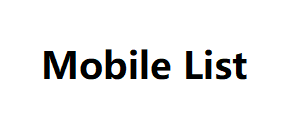The GTD method can be summariz with the following principle: the more productive we are, the less stress we will have. In other words, we should get more done in less time so that we can be more relax afterwards. The secret to this, according to the system develop by Allen, is to prioritize a to-do list in order to remove the clutter and Mobile List focus on what is important for the moment. At the same time, we must move uncomplet tasks into a reliable to-do queue, which will be touch on next. The GTD method requires the following tools: Inbox: space to write down all ideas, information, reminders – it can be a card , depending on the select tool; Trash: space where tasks that will not be perform are direct.
The GTD method requires the following
In 2001, such tools were still physical: a file cabinet and a desk calendar. Currently, digital versions of all these tools can be access over the phone. For some people, having a paper calendar or to-do list is the most reliable way to get organiz. But the reality is that technology has evolv a lot since the beginning of the century, and Ireland Email Database apps are here to stay. A digital GTD tool includes features such as automation and collaboration, functionality inaccessible in an old notebook or desk calendar. In addition to helping save time and money, these programs allow teams to work together. 4 organization apps that help save time and reduce stress For this selection, we focus on the five essential features of the GTD methodology—inbox, trash, filing system, checklists, and calendar—to present application options.
Easy data entry
In addition, the choices were made taking into account other requirements, such as the general evaluation of these tools on the Capterra page (check out the complete methodology at the end of the article). The list is in alphabetical order. 1. Asana Asana can be us to implement the GTD methodology Example task list in Asana ( Source ) In the context of the GTD system, Asana offers an inbox where you can create tasks, manage read and unread messages, archive notifications, and customize the space for viewing more or less notifications. In terms of task organization, the user can choose different types of views, such as boards, lists and schedules. If you choose the calendar view, you can access tasks and filter them by due date, for example. It includes different charts to track activity progress.

